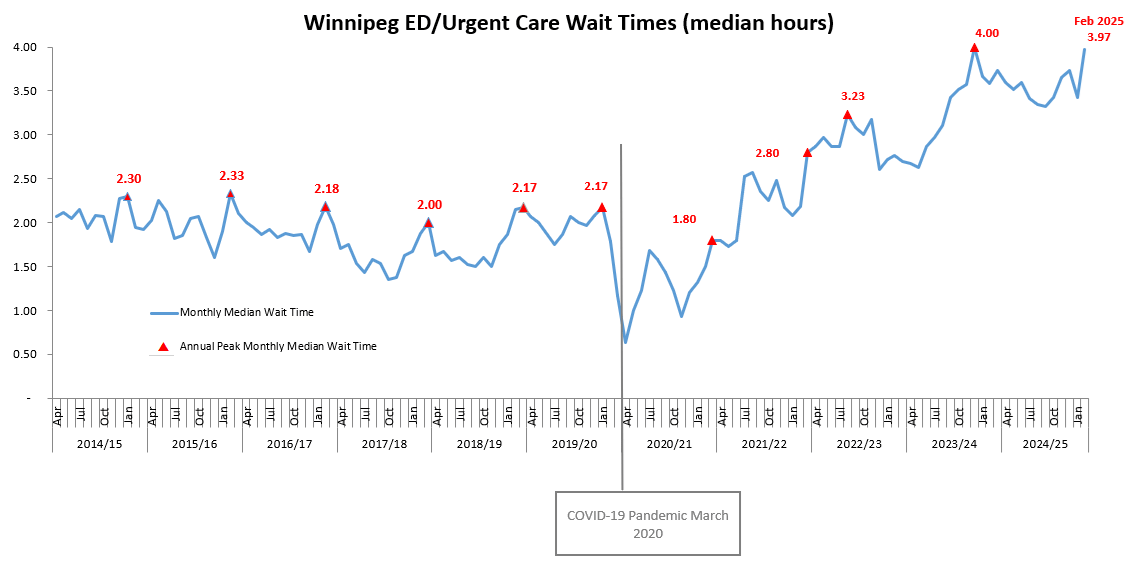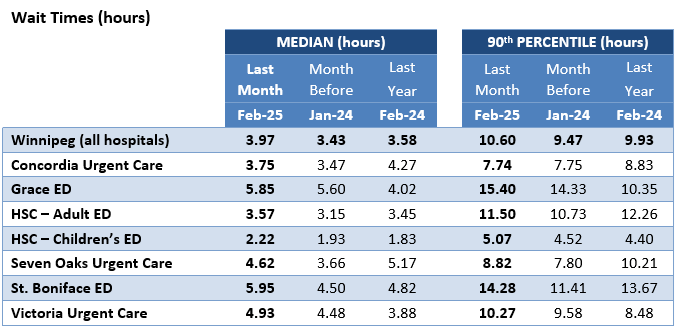Monthly Wait Time Reporting
WRHA reports Emergency Department (ED) and Urgent Care actual wait times on a monthly basis to help monitor our progress on improving access to care through the Healing our Health System plan and other changes to improve patient flow.
If you are a patient seeking an estimate for the current wait time at Winnipeg hospitals, please click here.
For wait time monitoring, it is important to consider the longer term trend as waits can vary monthly and seasonally depending on a number of factors. Peaks in patient volumes and the number of patients with more serious health issues can affect wait times. Seasonal variation also occurs, with elevated waits in winter months often coinciding with influenza, respiratory conditions and weather-related health issues such as slips and falls. Patients are encouraged to use urgent care or visit their doctor for less urgent health issues.
The chart below provides a monthly update on Winnipeg hospital median wait times as part of a longer term period to help monitor performance while considering the monthly and seasonal variations that occur.

A breakdown by site is available each month. For comparison to past performance, the month before is included along with the same month last year.
The reporting in the table below includes:
- The median wait (in hours). Median is a type of average that represents a wait time where half of patients had shorter wait times than reported and half had longer wait times.
- The 90th percentile (in hours). The 90th percentile represents helps to understand the minority of patients with longer wait times. Nine out of 10 patients experienced shorter wait times than the reported 90th percentile and 1 in 10 waited longer.

Questions and Answers
How are wait times calculated?
WRHA calculates wait times using the same method as the Canadian Institute for Health Information. The wait time includes the time between being registered upon arrival and seeing a doctor or nurse practitioner. This method has not changed.
For more information on how Emergency and Urgent Care wait times are calculated, please refer to CIHI's indicator library.
What do the reported wait time numbers mean?
Like CIHI and other organizations, the WRHA reports past wait times in hours. For example, a median wait time of 1.5 hours is the same as 1 hour and 30 minutes. A median wait time of 1.75 hours is the same as 1 hour and 45 minutes.
How is this different from WRHA's wait time clocks?
This web page offers actual wait times for ED and Urgent Care for WRHA's past performance. The WRHA's wait time clocks offer a real-time forecast of current wait times to help patients decide where to access care.
Is more information available on WRHA's past performance?
Annual reporting is available from the Canadian Institute for Health Information on their Your Health System site.
